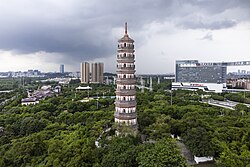| Pazhou Pagoda | |||||||||||
|---|---|---|---|---|---|---|---|---|---|---|---|
 Pazhou Pagoda in 2023 | |||||||||||
| Chinese | 琶 洲 塔 | ||||||||||
| |||||||||||
The Pazhou Pagoda,also known as the Whampoa Pagoda or Pa Chow Pogoda,is an early modern Chinese pagoda on Pazhou Island in Haizhu District,Guangzhou,the capital of China's Guangdong Province. [1]
| Pazhou Pagoda | |||||||||||
|---|---|---|---|---|---|---|---|---|---|---|---|
 Pazhou Pagoda in 2023 | |||||||||||
| Chinese | 琶 洲 塔 | ||||||||||
| |||||||||||
The Pazhou Pagoda,also known as the Whampoa Pagoda or Pa Chow Pogoda,is an early modern Chinese pagoda on Pazhou Island in Haizhu District,Guangzhou,the capital of China's Guangdong Province. [1]
Construction of the Whampoa Pagoda was initiated in 1597 and was completely built by 1600. [1] The pagoda is situated on a knoll at the south bank of Pearl River. Although it was built as a Buddhist landmark,it was also a useful navigation point for merchant ships traveling to Guangzhou. [1] [2] [3]
It is an octagonal tower with 9 main sections and 17 sub sections. [4] The tower stands at about 59 metres (194 ft),and has a diameter at the base of 12.7 metres (42 ft). [4] It covers a total area of 111 square metres. [4]
Functioning in a similar fashion to Chigang Pagoda,it was built for Fengshui and allow safe navigation of merchant ships traveling along the Pearl River towards Guangzhou. [4]
Media related to Whampoa Pagoda at Wikimedia Commons